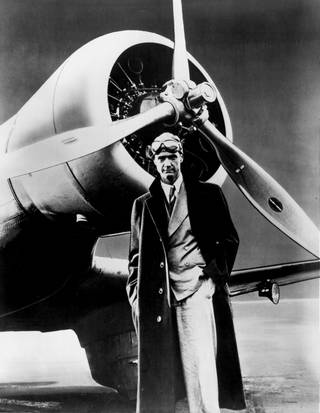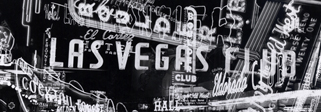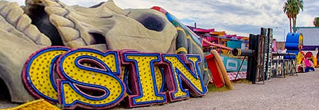Thursday, May 15, 2008 | 3 a.m.
Hughes Arrives In Vegas
When Howard Hughes arrived in Las Vegas in November 1967, many of the hotels were preparing their suites for the high rollers that would come stay for New Year's Eve. Bob Maheu recalls that he was finally able to get Hughes into one of the Desert Inn suites, but the aviator was not considered an important high rolling client and after about 10 days, the hotel was requesting that Hughes vacate the suite.
Howard Hughes was one of the brightest figures in Las Vegas’ neon history. But he came to Las Vegas under the cover of darkness during Thanksgiving weekend in 1966. Hughes rode in on a fortune. His father had invented an oil well drill bit that could penetrate hard rock, leaving his son one of the richest people in the world.
Howard Robard Hughes Jr. arrived on that dark night for a private holiday, never intending to buy a hotel, according to longtime Hughes confidante, “alter ego” and public liaison Robert A. Maheu. But for the next four years Hughes would wield his fantastic wealth to change and modernize the Las Vegas Strip.
Hughes had visited Las Vegas during World War II, staying at the Desert Inn, El Rancho Vegas and the Flamingo. In the early 1950s he acquired about 40 square miles near Las Vegas from the BLM, trading 73,000 acres of desert land in five Northern Nevada counties for the federal parcel. It was known as “Husite” before being transformed into today’s Summerlin master-planned community.
When Hughes finished buying the land, his Nevada holdings were worth an estimated $300 million. His empire included Harold’s Club in Reno, nearly every vacant lot on the Las Vegas Strip, an airline, several Nevada ranches and about 2,000 mining claims.
Hughes’ 1966 stay in Las Vegas wasn’t his first: In 1953 the 47-year-old tycoon leased a small, five-room cottage near the Desert Inn, calling it the “Green House” for its exterior color, which stood out against the brown desert. He lived in the Green House for nearly a year, ordered it to be kept exactly as it was when he left it, despite never returning there.
A dozen years later, on that night in 1966, Hughes’ two-car private train arrived in Las Vegas. His aides whisked him to the Desert Inn penthouse. As the story goes, Moe Dalitz, the DI’s general manager, asked Hughes to vacate the penthouse because it was needed for the expected influx of New Year’s Eve guests. Instead, Hughes bought the hotel.
Community officials bent the rules to accommodate their new resident, hoping he would be a great benefactor. Despite Hughes’ refusal to be photographed, fingerprinted or fill out financial disclosure papers, the tycoon got a license to operate the Desert Inn from the Nevada Gaming Commission in 1967.
Hughes Buys Desert Inn
Having overstayed his welcome, Howard Hughes was almost physically kicked out of the Desert Inn when Bob Maheu jokingly suggested to his boss that he buy the hotel in which he had taken up residence over the past four months. Hughes agreed and so began the billionaire recluse's foray into Las Vegas real estate.
After buying the Desert Inn for $13 million, Hughes went on a roll. He bought the Sands for $14.6 million, the Frontier for $23 million and the unfinished Landmark, which had stood empty for eight years, for $17 million. His other on- and off-Strip properties included the Desert Inn Country Club’s residential lots, the North Las Vegas Airport and all the land surrounding McCarran International Airport and several casinos that operated under the umbrella Summa Corp.
Before Hughes bought the Frontier in December 1967 he (or someone claiming to be the billionaire) called Gov. Paul Laxalt to assure the state he would continue his good deeds. Hughes’ handwritten offer said he would establish a medical school at UNLV and promised $200,000 to $300,000 a year for 20 years. However, he never funded Nevada’s medical school, which was established after the billionaire left Nevada.
At times, Hughes was a study in contradiction. Although he had clearance to view top-secret government information because of multimillion-dollar defense contracts with Hughes Tool Co., he did not agree with all government policies. Most notable was his opposition to nuclear weapons explosions at the Nevada Test Site, 65 miles northwest of Las Vegas.
While living at the Desert Inn, Hughes tried to stop the explosions at the Test Site, but never persuaded the government to halt them. Hughes was concerned tourists would become frightened of the atomic blasts and stop coming to Las Vegas. He also feared the rumbles felt in the valley from the tests might damage his numerous properties.
Hughes envisioned Las Vegas as a model metropolis with its own high-speed train, a city with clean air and clean water in the middle of the desert, according to memos he wrote. Sewage going into Lake Mead, the source of drinking water for Las Vegas, was one of the former engineer’s major concerns.
Never Face to Face
Despite Bob Maheu's constant services to Howard Hughes throughout the 1960s, Maheu never actually met Hughes face-to-face, rather he communicated with the business man through memos and telephone conversations. Maheu discusses the phone conversation in which Hughes revealed why he could not arrange a personal meeting with the man in which he had given complete control of his business dealings.
The man who never left the Desert Inn’s penthouse had other things on his mind. Once he was ensconced in the penthouse, he withdrew into his own world of movies on television, drugs and excessive paranoia about germs. He even wrote directions to his staff about how many tissues they needed to use to carry items in and out of his suite.
When Hughes first arrived in Las Vegas he discovered he couldn’t indulge in one of his whims. A chronic insomniac, he wanted to watch movies on television when most people were asleep, a habit harking back to his Hollywood days at RKO Studios. But Las Vegas had no all-night TV stations. Las Vegas Sun Publisher Hank Greenspun sold his television station (KLAS Channel 8) to Hughes in September 1967 for $3.6 million. The former movie mogul now had a 24/7 channel.
After four years in Las Vegas, Hughes left abruptly. On Thanksgiving Eve 1970, Hughes was reportedly carried out of the Desert Inn on a stretcher, driven to Nellis Air Force Base in an unmarked van and flown by private jet to Resorts International’s Brittania Beach hotel in the Bahamas.
Getting Las Vegas Ready
Even though Howard Hughes owned much of the land that today has become the Las Vegas that people know and love, Bob Maheu reminds people that if it weren't for Hughes' death, much of that land would still be Hughes' and would still be a desolate desert.
The billionaire never returned to Las Vegas, although his legacy continues to feed the city’s lore and legend.
A bitter corporate struggle ensued in Las Vegas over Hughes’ empire. Hughes’ once-trusted aide, Maheu, personal physician Dr. Robert Buckley and other top officials were fired after he left the DI’s penthouse.
Summa Corp. Executive Vice President Frank William Gay and Chester Davis, a Wall Street lawyer who defended Hughes in a lengthy and successful battle over alleged antitrust violations involving TWA, ousted Maheu after arriving at the Sands Hotel in December 1970. Laxalt delivered the news to Maheu on Dec. 7. “He told me he had spent over a half hour talking with Howard, and that Hughes had told him that I was fired,” Maheu recalled in his autobiography, “Next to Hughes.”
Hughes, who was born on Dec. 24, 1905, died on April 5, 1976, on a plane flying from Mexico to Houston.
Summa insiders and his heirs began battling over Hughes estate. At first, Davis sought out Hughes’ closest relative, Houston lawyer Will Lummis, the son of a maternal aunt. Davis suggested Lummis become temporary sole stockholder of the estate and that he join the Summa board. In August 1976, Lummis became Summa’s chairman. Gay, who commanded Hughes’ “Mormon Mafia” of personal aides, was Davis’ ally. He became chief executive officer that same year. Davis remained chief counsel and a board director.
Howard Hughes' Alter Ego
Bob Maheu describes how he transformed from Howard Hughes' right hand business man, into the billionaire's alter ego.
Lummis discovered that from 1971 through September 1976 Summa lost $132 million, in part because of inexperience people running Hughes’ casinos. At a tense board meeting on May 18, 1977, Davis led the directors to vote down all of Lummis’ proposals. An angry Lummis kicked Davis off the board on May 26, although Davis remained general counsel.
The lengthy legal battles weren’t settled until 1984 when courts rejected claims by California and Texas that Hughes’ estate owed inheritance taxes. In 1985 the U.S. Supreme Court ruled Hughes Aircraft was owned by the Howard Hughes Medical Institute, which was sold to General Motors that year for $2.5 billion.
In the years that followed Hughes’ death, numerous documents turned up purporting to be the billionaire’s will. However, judges ruled none was legitimate. One of the more intriguing wills was submitted by Utah gasoline station operator Melvin Dummar, who claimed to have once given Hughes a car ride.
Hughes’ estate was eventually divided among 23 relatives, led by Lummis, in 1983. Summa Corp. was renamed the Howard Hughes Corp. in 1994.
“My heart still bleeds for what happened to Howard Hughes,” Maheu told the Las Vegas Sun in 2004. “I often said after I got off the phone with him that I just finished talking to the poorest man in the world. He was so unhappy.”


 Explore Las Vegas’ past and present
Explore Las Vegas’ past and present Boomtown: The Story Behind Sin City
Boomtown: The Story Behind Sin City Neon Boneyard: A 360° look
Neon Boneyard: A 360° look Mob Ties: See the connections
Mob Ties: See the connections Implosions: Classic casinos crumble
Implosions: Classic casinos crumble